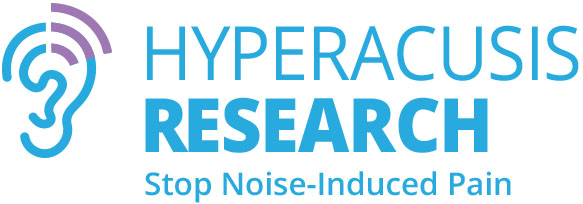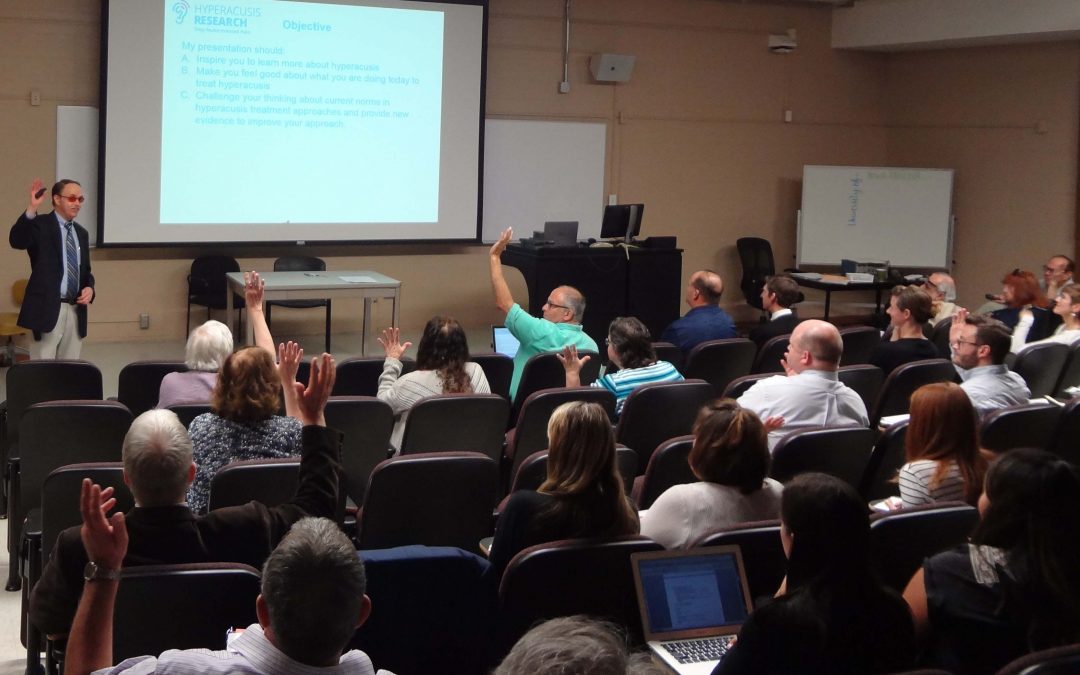 Hyperacusis Research president Bryan Pollard spoke to doctors and audiologists at the University of Iowa’s 26th Annual International Conference on the Management of the Tinnitus & Hyperacusis Patient. Bryan’s topic was “Innovating a Better Future for Sufferers of Hyperacusis with Pain.”
Hyperacusis Research president Bryan Pollard spoke to doctors and audiologists at the University of Iowa’s 26th Annual International Conference on the Management of the Tinnitus & Hyperacusis Patient. Bryan’s topic was “Innovating a Better Future for Sufferers of Hyperacusis with Pain.”
Bryan started with a focus on listening to the voice of the patient as he shared the Cure for Cindy video. Bryan then shared two other hyperacusis patient stories and their treatment approaches including tinnitus retraining therapy (TRT). The patient who improved the most actually chose his own approach which included moving to remote quiet house for a period of time and which was followed by a gradual exposure to louder sounds. The variability of results with current treatment approaches is one of the reasons further research is needed to find a cure for all – especially those who have noise-induced pain.
Next Bryan described the need to advance clinical understanding. A key mechanism Hyperacusis Research is relying on is our Sanford CoRDS Hyperacusis Survey. With over 200 participants this data has the most comprehensive information for those who experience hyperacusis with pain. Bryan shared the results with a unique approach to describing the life of a “classic patient” with example statements below:
- Prior to hyperacusis, about half of us had a history of loud noise exposure, with about 1/3 having a traumatic impulse noise exposure.
- For the vast majority, we experience pain at least every day and for some continuously – usually a result of being around a new loud noise.
- The pain is a sharp, dull ache, stabbing or burning pain.
- The pain lasts 5 hours to several days for half of us.
- About 1/3 of us have regular setbacks from new loud noises which make some of us worse than we ever were.
- For those of us who recover from setbacks, it takes several days and that is dependent on the loudness of the new sound exposure.
Bryan ended this section by stating: “What we care about most is the number of days we are in pain. Sound therapy had the least affect for those with the most days in pain. A critical factor that affects the number of days in pain is setbacks. Fewer setbacks results in less pain.”
Bryan next described a new Hyperacusis Assessment Method by Greenberg and Carlos. The new tool, called the Inventory of Hyperacusis Symptoms (IHS), was developed to measure symptom severity, treatment outcomes, and diagnostic differentiation. While there are a number of potential advantages of this tool compared to the current “Hyperacusis Questionnaire” by Khalfa, this new tool includes the topic of pain.
Bryan next focused on the work to advance research for hyperacusis starting with a paper by Londero, et al., titled “A Case of Acoustic Shock with Post-trauma Trigeminal- Autonomic Activation Front.” While middle ear effects are frequently overlooked as potential players in hyperacusis with pain, this work describes a potential cascade of events that could explain many aspects for some patients. A patient who worked as a general medical practitioner at the time of acoustic shock which resulted from nearby gun fire was able to take unique steps to document his experiences starting with a photograph of his eardrums. The patient’s chronic symptoms included tinnitus, otalgia, tingling in the ear, tension in the ear, and red tympanum as well as pain in the neck and temporal region. The authors suggest that these symptoms may result from a loop involving injury to middle ear muscles, peripheral inflammatory processes, activation and sensitization of the trigeminal nerve, the autonomic nervous system, and central feedbacks.
Some of the most advanced animal model work on hyperacusis with pain is being completed at the University at Buffalo. Bryan described Senthilvelan Manohar’s Auditory Nociception Test (for more details, see the grant Hyperacusis Research funded in 2017). The Auditory Nociception Test (ANT) is based on a traditional pain threshold assessment. Although animals show an elevated pain threshold in the presence of 90 and 100 dB, at 110 and 115 dB they show a reduced pain tolerance. This can be used to develop models that can be used to uncover mechanisms of pain in hyperacusis.
Bryan concluded by emphasizing that clinicians should take a very personalized approach to patients and work with each one carefully to ensure they can make forward progress without having setbacks.


HOW MUCH DOES THE ARMY UNDERSTAND ABOUT HYPERACUSIS AND TINNITUS. I HAVE HAD HYPERACUSIS SINCE DISCHARGE 1953 RESULTING FROM EXPLOSIONS,
THE ARMY RECOGNIZES MY CONDITION AS TINNITUS.
PLEASE INFORM THE ARMY THERE IS A DIFFERENCE. THA K YOU.
PAUL T.
Is there a 2019 Hyperacusis conference scheduled?
I perforated my Left ear drum June 2018 at which time I had terrible pain in that ear but also an immediate excruciating sharp pain the the Right ear as well. I had immediate hearing loss and tinnitus in the Left ear and hyperacusis in the Right ear. About 2 months later, both of my ears developed intense pressure pain and felt full 24/7 (still does a year later); my entire head started to feel like it could explode. Brushing my teeth, hair, the sound of my own voice, sound of running water, birds chirping, etc. causes extreme pain in my ears. Swallowing has even begun to increase the pressure in both ears causing intense pain. The pressure and pain even worsens when I am up moving around as well so I have to lay down most of the day. I have NO quality of life at all. ENT’s say my Left ear has healed and they see no physical problem that would cause this. I’ve seen multiple Neurologists and Neurotologists and no one has any idea of what is causing all of my pain. My condition is progressively getting worse. I had been using an earplug in the Right ear to help lessen noise exposure and the pain and started using noise cancelling headphones when I just couldn’t take the noise and pain anymore. Since then I have learned that doing this may worsen hyperacusis so I am now trying to avoid wearing these. Ive tried to use a white noise machine in my room at night but always wake up in excruciating pain after doing so, so I’ve stopped that. The pressure in my ears has been constant without relief for 11 months now! Does anyone have any idea of a practitioner experienced in this area that could help me?